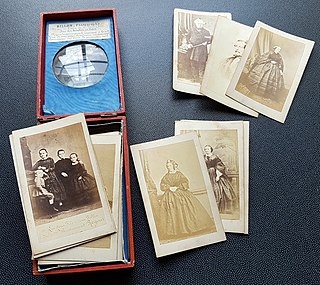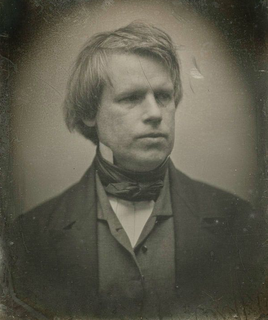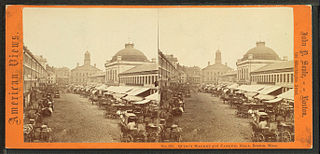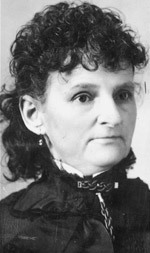Images
- Portrait of Leonard Grimes by G.H. Loomis (New Bedford Historical Society)
- Advertisement for Loomis' Gallery of Photographic Art, Tremont Row, Boston, 1868
- Portrait of a woman by G.H. Loomis
- Logo of "G.H. Loomis, cartes de visite," Boston
Grove Hinman Loomis or G.H. Loomis (1823-1898) was a photographer in Boston, Massachusetts, in the mid-19th century. He also worked as a real estate broker, teacher and government employee. [1] [2] He died in Newton, Massachusetts in 1898. [3]

The carte de visite, abbreviated CdV, was a type of small photograph which was patented in Paris by photographer André Adolphe Eugène Disdéri in 1854, although first used by Louis Dodero. Each photograph was the size of a visiting card, and such photograph cards were commonly traded among friends and visitors in the 1860s. Albums for the collection and display of cards became a common fixture in Victorian parlors. The immense popularity of these card photographs led to the publication and collection of photographs of prominent persons.

James Wallace Black, known professionally as J.W. Black, was an early American photographer whose career was marked by experimentation and innovation.

André-Adolphe-Eugène Disdéri was a French photographer who started his photographic career as a daguerreotypist but gained greater fame for patenting his version of the carte de visite, a small photographic image which was mounted on a card. Disdéri, a brilliant showman, made this system of mass-production portraiture world famous.
The cabinet card was a style of photograph which was widely used for photographic portraiture after 1870. It consisted of a thin photograph mounted on a card typically measuring 108 by 165 mm.

Zaida Ben-Yusuf was an English-born, New York–based portrait photographer noted for her artistic portraits of wealthy, fashionable, and famous Americans during the turn of the 19th–20th century.

Josiah Johnson Hawes (1808–1901) was a photographer in Boston, Massachusetts. He and Albert Southworth established the photography studio of Southworth & Hawes, which produced numerous portraits of exceptional quality in the 1840s–1860s.

John Payson Soule (1828-1904) was a photographer and publisher in Boston, Massachusetts, and Seattle, Washington.
William Henry Getchell (1829–1910) was a photographer in 19th-century Boston, Massachusetts. He was born in Hallowell, Maine, on March 10, 1829. He lived in Peoria, Illinois, and then moved to Boston. In 1857 he married Sarah Hartwell; they had one child—Frederick Getchell. In the early 1860s Getchell worked in Boston with George M. Silsbee and John G. Case as Silsbee, Case & Co.; and again with Case as Case & Getchell, ca.1862-1864. He later ran a solo photography studio in the 1860s and 1870s. As of 1898 he lived in Dorchester. He died in Boston in August, 1910.
The National Photographic Association of the United States (1868–1880) formed "for the purpose of elevating and advancing the art of photography, and for the protection and furthering the interests of those who make their living by it." In particular, the group organized initially to prevent "the reissue of the ... ambrotype patent."
Antoine Sonrel was an illustrator, engraver, and photographer in Switzerland and Boston, Massachusetts, in the 19th century. He moved from Neuchâtel to the United States around the late 1840s, and was affiliated with Louis Agassiz throughout his career. As a photographer he created numerous carte de visite portraits in the 1860s and 1870s; subjects included his friend Agassiz, Oliver Wendell Holmes, Sr., Oliver Wendell Holmes, Jr., Abbott Lawrence Rotch, and sculptor Anne Whitney.
Edward L. Allen or E. L. Allen (1830–1914) was a photographer in the 19th-century United States. He kept a studio on Temple Place in Boston, Massachusetts. For some years he worked in partnership with Frank Rowell. Examples of Allen's photographs reside in the Boston Public Library and the Boston Athenaeum.
Amory Nelson Hardy or A.N. Hardy (1835–1911) was a photographer in Boston, Massachusetts, in the 19th century. Portrait subjects included US president Chester A. Arthur, clergyman Henry Ward Beecher, politician James G. Blaine, abolitionist William Lloyd Garrison, doctor Oliver Wendell Holmes Sr., jurist Oliver Wendell Holmes Jr., writer Julia Ward Howe, labor activist Florence Kelley, suffragist Mary Livermore, philanthropist Isabella Somerset, and suffragist Frances Willard. He also made "electric-light portraits" of roller skaters in 1883.
Ernest Ferdinand Ritz was a Swedish-American photographer in Boston, Massachusetts during the 19th century.

Count Olympe-Clemente-Alexandre-Auguste Aguado de las Marismas was a Franco-Spanish photographer and socialite, active primarily in the 1850s and 1860s. One of several early photographers who learned the practice from Gustave Le Gray, Aguado pioneered a number of photographic processes, including carte de visite photographs and photographic enlargement processes. He was also a founding member of the influential French Photographic Society in 1854.

Theodore M. Schleier was a Prussian-born American photographer, inventor, and diplomat, active primarily in the southeastern United States in the latter half of the 19th century. While operating from a studio in Nashville, Tennessee, he helped document life in the city during the Civil War. He later moved to Knoxville, Tennessee, where he captured some of the city's earliest photographs. His inventions include an early artificial lighting system for photography studios.

Hannah Hatherly Maynard was a Canadian photographer best known for her portrait work and experimental photography involving photomontage and multiple exposures. She also photographed people using techniques that made them appear as statuary: on columns or posing as if they were made of stone.

Sarah James Eddy was an American artist and photographer who specialized in the platinotype process, also known as platinum prints. She was active in abolition, reform, and suffragist movements, and was a philanthropist as well as instrumental in the founding of the Rhode Island Humane Society. She was inducted into the Rhode Island Heritage Hall of Fame in 2017.

Benjamin Franklin Upton was a photographer who produced stereoscopic views in the United States, especially of natural features, architectural sights, pineries and recreational endeavors around the Minneapolis, St. Anthony, and Saint Paul area and its surroundings. Some of the images were labelled "Upton's Views".
The solar camera, or solar enlarger, is an ancestor of the darkroom enlarger, and was used in the mid-to-late 19th century to make photographic enlargements from negatives.
Frederick Henry Coldrey was an early Australian portrait photographer active c.1855 to 1889.
| Wikimedia Commons has media related to G.H. Loomis . |